Gear Selection
This pretty much applies to any trans, but since I only
know the 020 really well, I'll specify just the 020.... but the 02A/J, etc.
will pretty much be the same principal of operation.
I guess the first thing to do is identify the parts that will be discussed.
I'm not sure if the names are correct technically, it's just what I call
things (cover my ass there).
The input shaft is the shaft the clutch fits onto, it is spun by the
engine at engine RPM speed when the clutch is engaged and connecting the
engine and trans together.
The output shaft is the shaft that is also called the pinion shaft,
it spins the diff in the trans, which is then directly connected to the
wheels.
The synchronizer or sync rings are brass rings that work using
friction against the gear faces.
The sync hub assembly is a sync hub on the shaft, and a sliding
sleeve or collar that fits over the hub.
The sync keys and sync springs are contained inside the sync
hub assembly.
All of the forward gears are constantly meshed, it is a syncromesh box. The gears are always meshed, but not always locked to the shaft they are on. When you shift into a gear via the shifter in the car, you are actually locking a gear to the shaft.
Here is a pic showing a gear set, you can see the actual helical cut gears themselves are meshed together and they always remain this way...
One gear in each of the 5 forward gear sets is a freewheel gear and it will
be on a needle bearing, able to spin at a different speed than the shaft it
is riding on. The mating gear on the other shaft will be splined to that
shaft, and will always spin with the shaft speed.
This means that all 5 gear sets (10 gears) for the forward gears will all be
constantly meshed together, and they will each have one gear in the set that
is on a needle bearing. This is the gear the sync ring rubs against. The
mating gear on the other shaft will be splined to the shaft, and can
essentially be considered a part of the shaft. If the shaft moves, so does
that splined gear.
The freewheel gears that spin on needle bearings are
locked to, or unlocked from, the shafts by the sliding sleeve of the sync
hub assembly.
The hub is always splined to the shaft, so it spins at shaft speed as does
the sliding sleeve on the hub, the brass sync ring, the sync keys, and the
sync springs... all at shaft speed with the splined sync hub.
Here is a pic, this is of the 5th gear hub, but it works
for explaining where the parts are with the hub assembly.
The hub is always splined to the shaft, it alwasy contains the sync ring,
keys and springs, and it always next to a freewheel gear on the needle
bearing.
Notice the hub has 3 slots where the keys fit. The keys are normally shoved
outwards by the springs. The springs shove the keys into the sliding sleeve.
Also notice that the width of the slots in the hub match the width of the
sync keys. There is no slop there... this will be important later. Also
notice that the depth of the slot in the hub is deeper than the key... you
can push the keys inwards towards the center of the hub a bit, against those
springs...
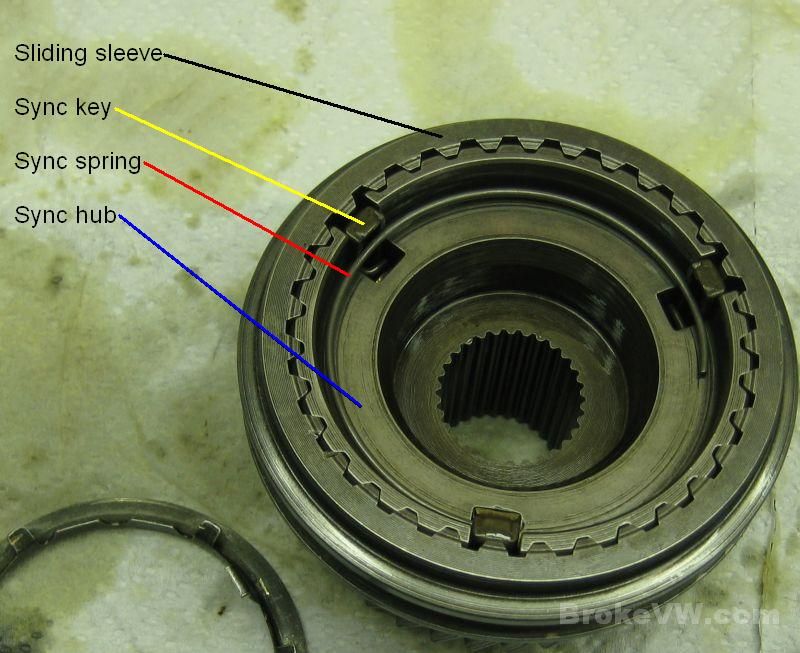
Inside the sleeve there are detent spots for the keys to fit into... the keys nest into those detent spots, which are angled cuts in one of the splines inside the sleeve. The sync key will want to sit right in the middle of the detent spot. Notice the splines inside the sliding sleeve are pointed on the tips, or angled to a point...
Here is a pic showing the sync keys (the dull powdery coating is how they come from VW). Notice the bump in the middle of the key... this bump fits into the detent spots inside the sliding sleeve above...
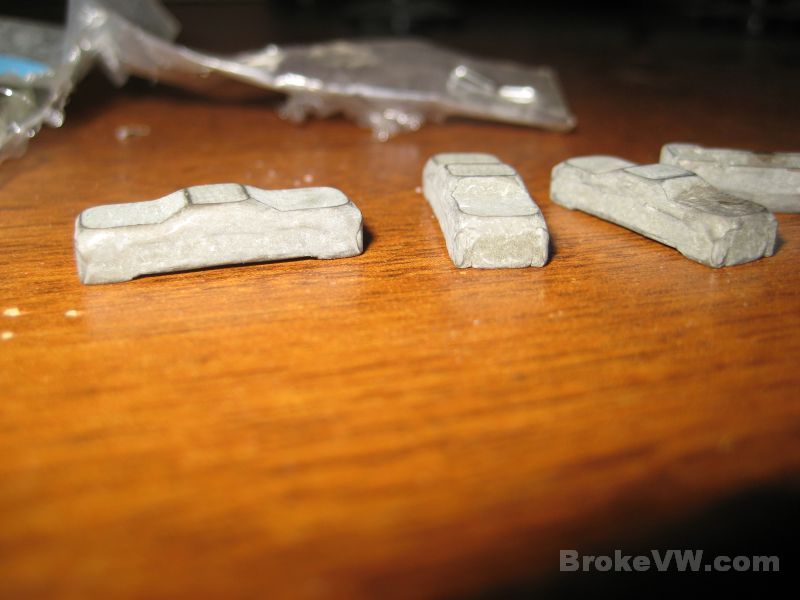
Here is another pic, this shows just the sync hub splined to the shaft. It has the springs installed, but no sliding sleeve, no keys, and no sync ring on top. There is the sync ring on the bottom for that freewheel gear. Above this hub will be another needle bearing, another freewheel gear, and another sync ring for that gear. Then the keys and sleeve go on.
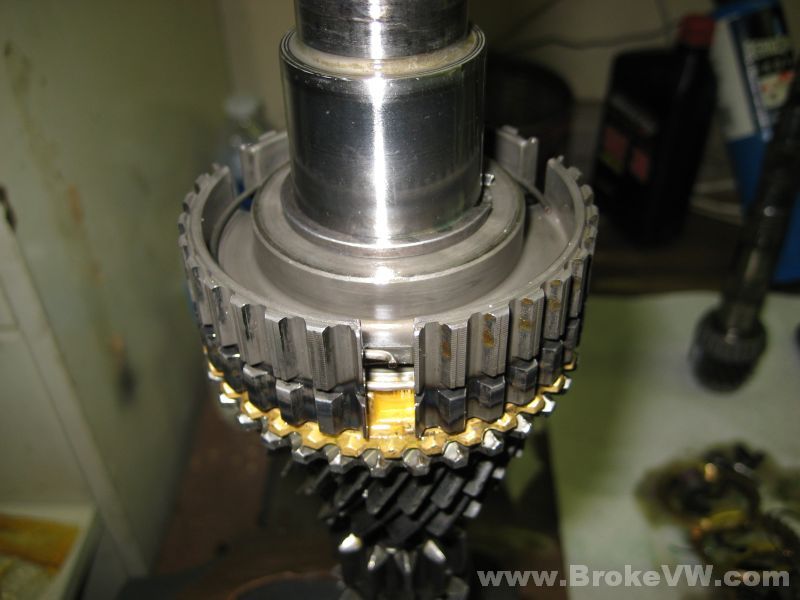
Here are a few good close pics of a sync ring. In the 1st pic, you can see there is a notch in the ring, there are 3 of them, one for each sync key....
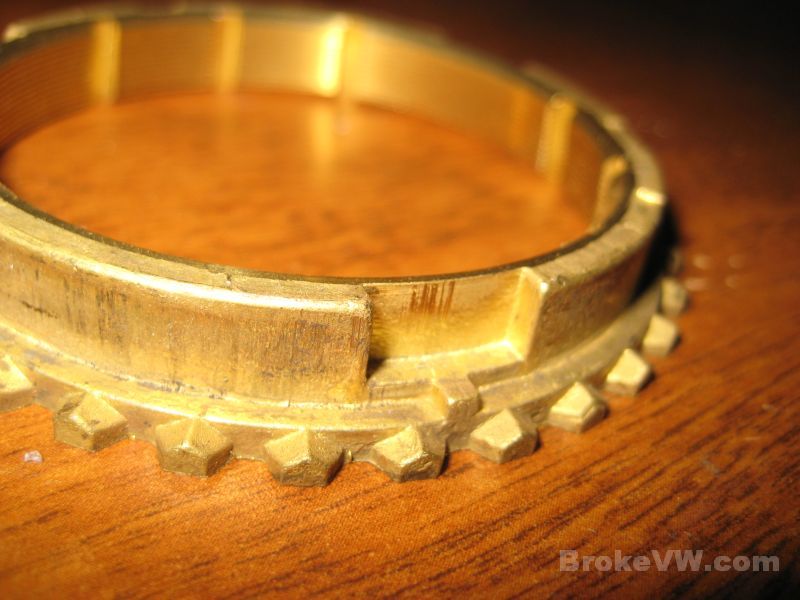
This pic shows the inside of the sync ring, this is what makes the friction against the smooth gear face of the freewheel gear to speed or slow the gear. Some are smooth with a couple deep oil grooves, some are like this with fine ridges, some are smooth with a helical oil groove, but they all do the same thing... make friction against the gear face...
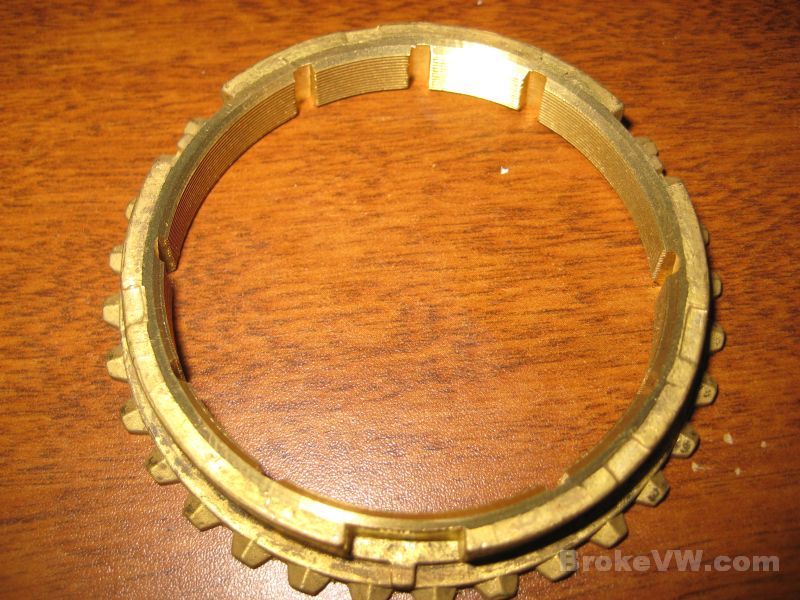
This is an important pic. It shows the notch in the sync ring, and a sync key inside it. Notice the slot is about 50% wider than the sync key itself. This results in some needed slop, to be explained shortly. Make note of the small teeth around the edge of the sync ring. They are pointed on top when new as shown in this pic. They almost remind me of the tiny green houses you get in a Monopoly game, a square key with a pointed top like a roof peak. You will find the same small teeth along the top of each freewheel gear. These small teeth are spaced and sized to match the splines inside the sliding sleeve, the sliding sleeve will fit over these small teeth...
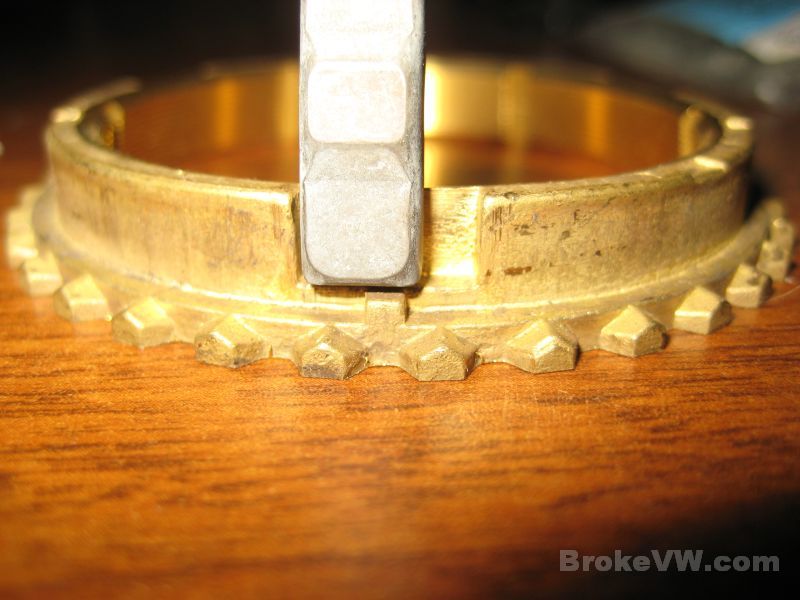
OK, just to re-cap, we have a sync hub splined to the shaft. We have a couple springs in the hub, they shove out on the 3 keys in the hub. The 3 keys fit into the slots in the hub, without slop. The brass sync ring fits over the gear face, and the 3 sync keys of the hub engage the 3 notches in the sync ring, which are 50% wider than the key.
This means basically that the sync ring spins at shaft speed always, but that if you hold the shaft stationary and you try to spin the sync ring, it WILL spin a little bit either way... but only as far as the slop shown in the pic above.
OK, if you're still reading this is what happens when you move the shifter in the car... the shifter will move the linkage, then the selector assembly, and then one of the shift forks in the trans. The shift fork will then try to slide the sleeve one way or the other, attempting to slide it over the gear you are trying to select.
When the sleeve starts to slide, the keys, which are shoved into the detent spots, will resist the movement of the sleeve. The bumps and low spots in the sleeve detents means that in order for the sleeve to slide, those keys have to get out of the way. They then, via the ramped profile of the key and detent spots in the sleeve, are shoved inwards into the hub, against the springs. This is why the slots are deeper than needed, so those keys can be shoved in towards the center of the hub or the shaft.
When the keys are shoved in, then the sleeve can slide on the hub, and it can slide over the gear and select it.... BUT... before this happens the keys will be resisting being shoved inward because of the springs. What happens is that the keys are actually shoved towards the gear, trying to slide with the sliding sleeve.... but they can't slide because of the brass sync ring.
This is where it all works to allow you to shift... the keys, sliding with the sleeve as you move the shifter and forks, will get shoved into the sync ring which shoves the ring into the gear face. Now the friction starts between the brass sync ring (always moving at shaft speed with the hub, keys and springs) and the gear face (spinning freely on a needle bearing on the shaft).
This will force that gear to either speed up or slow down... but it is going to be forced to spin at the same RPM that the shaft (and hub, keys, springs, and sync ring) are spinning at. When it matches that shaft speed, it is no longer using the needle bearing it is on, by the way.
OK, once the gear RPM is matched to the shaft RPM via the
sleeve shoving the keys into the brass sync ring and into the gear face, the
sleeve is now able to slide further off the hub and it will partially slide
over the freewheel gear. When it does, you are in gear, it is officially
selected at that point.
To get the sleeve over the gear though, those keys had to be shoved down
into the ring until the force of the sliding sleeve was great enough to over
power the sync springs. When the sync springs are over powered, they allow
the keys to get pushed in towards the center of the hub, and out of the way
of the sleeve, which is then free to slide over the gear... assuming the
brass sync ring has, at this point, used friction to match the gear speed to
the shaft speed.
If the sync ring has NOT managed to match speeds... you
grind the gear. Shift too fast in 2nd and hear that Grrrrrrrk! grinding
noise? That would be the sliding sleeve grinding into the actual gear.
If you shift slowly, keeping steady pressure on the shifter in the car, you
will slowly shove the sliding sleeve into the keys, into the sync ring, into
the gear face, and friction will have been given enough time to change the
gear RPM to match that of the shaft. When it matches, no grinding of the
gears.
OK, here are a couple pics of a dirty trans I cut up for demonstration purposes (and I had a band saw I wanted to play with)... this 1st pic shows the input shaft and you can see the sync hub sleeve, a shift fork in the middle of that, and above and below the sleeve are a couple freewheel gears. 3rd is the bottom one, 4th is the top one, in case you were wondering.
In this pic, the trans is not in gear. The sliding sleeve is in the middle of the hub, and isn't partially covering a gear...
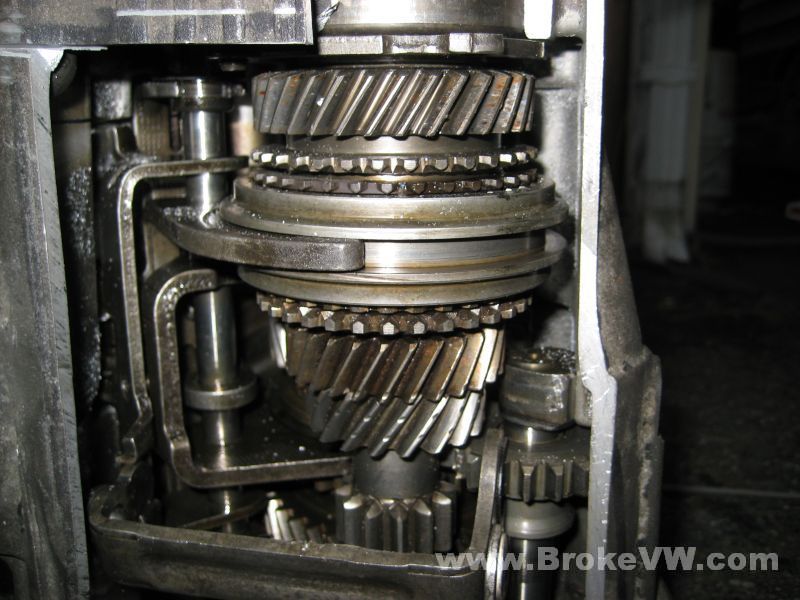
4th gear selected. Notice the sleeve has moved up and is partially covering 4th gear. It is also partially covering the sync hub. That is your connection between the gear and the shaft, that is how it is selected. All power will pass from the hub, into the sleeve, from the sleeve and into the gear... so when you beat up on the trans, that sleeve is just one of many parts holding it all together :)
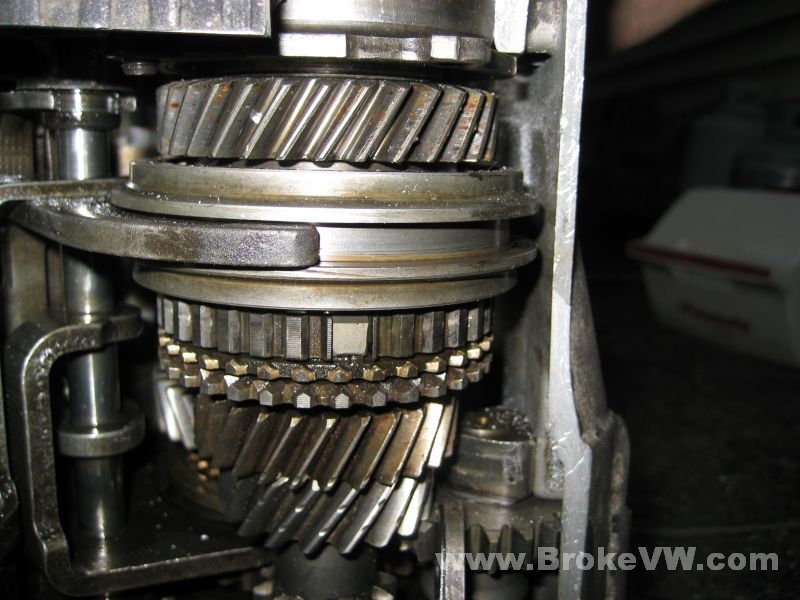
Here is 3rd gear selected. The sliding sleeve has moved down. In this and the pic above, you can see when the sleeve is over a gear, it is moving over top of small teeth at the top of the gear. The sync ring has the same small teeth on it. These are the small teeth that remind me of the Monopoly houses. Notice that the tops of these small teeth point in towards the hub, and away from the gear. In other words, the pic below show the small teeth of 4th gear and the 4th gear brass sync ring pointing down. In the pic above, the teeth for 3rd and the 3rd sync ring are pointing up.
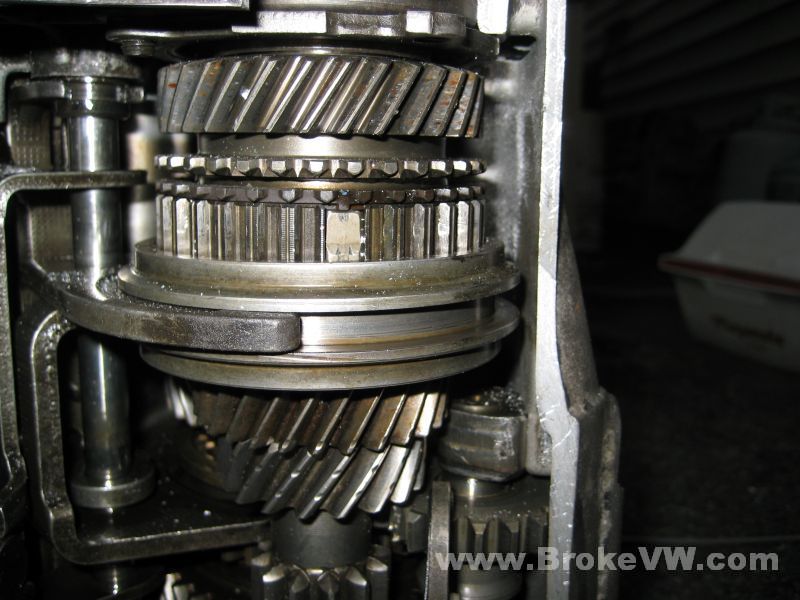
When you grind a gear from shifting too quickly, the noise
you hear are the angled tips of the Monopoly house roof of the small teeth
on the actual gear clashing against those splines on the inside of the
sliding sleeve that also have pointed tips. The pointed tips are bashing
into each other as the gear (which isn't at matched speed to the sleeve) and
sleeve spin at different RPM as you attempt to slide the sleeve over the
gear.
The result is that the tops of the little house teeth get rounded over,
flattened out, etc... they are no longer sharp.
When they aren't sharp, you have a greater chance of the splines inside the sleeve hitting the small teeth of the actual gear point-to-point... because the gear is free to spin until needed, the small teeth on the gear won't always align up with the splines inside the sliding sleeve.
This is where the slop in the sync ring, with the notch being 50% wider than needed, comes into play. With the slop there, the ring is free to move either way about half a small tooth, or half a Monopoly house. This will ensure the sleeve can slide over the gear without hitting point-to-point because if it does just happen to align point to point like that, the angled tops of the teeth and splines will shove each other to the side a bit as they slide past each other. If we had no slop, no 50% wider notch, then nothing would be able to move to the side one way or the other a little bit. With the slop, the gear and sync ring can move a bit either way together to allow the sleeve to slide over the gear.
Have you ever tried to grab 1st at a dead stop, only to
have it feel like you hit a brick wall and it wouldn't select? That's the
sleeve hitting the small gear teeth point-to-point, and they aren't shoving
each other to the side a little bit in order to slide past each other. The
result is that the sleeve stops, so do the forks, the selector, and finally
the shifter.
If you move the car a little bit, or if it is slowly rolling, it slots right
into gear because if you do happen to hit point to point, with the shaft and
gear rotation, it is much more easy for them to slide past each other when
moving.
To demonstrate this further... engine off, no clutch pedal
depressed. Run the trans through the gears. It feels notchy and shitty, and
you might have to try a couple gears more than once to get it to select.
This is the small teeth on the gears and the alignment of those with the
splines inside the sliding sleeve you are feeling. With the engine off and
the car not moving, both shafts are stopped as well as all of the gears, and
to get the small teeth to slide past each other, you need to use a little
more force to get it engaged.
If you are sitting with the engine off as above, select a gear... it might
be tough to get into, or notchy. When you get it selected, pull it out of
gear, then slip it back into the same gear. Butter. The angled small
Monopoly house teeth and the pointed/angled splines of the sliding sleeve
have shoved each other to one side and have slid past each other once
already... since nothing is moving, you can now slide the sleeve over the
gear and back off again as much as you like without hitting point-to-point
again, they've already aligned.
As soon as you select another gear, you'll force the parts to all re-align,
and then that new gear will select over and over again like butter, but the
original gear you did it with may not. It totally depends on the alignment
of the parts inside.
When you are driving, everything is moving and it is easy for the parts to
self-align as they slide past each other.
If you beat the tops of those small teeth up (and the angled tips of the splines inside the sliding sleeve), you run a greater chance of them NOT sliding smoothly past each other, even when rolling and driving. If that happens you can usually let off the shifter, try the gear again, and it will likely drop right in as the sleeve slides over the gear.
So there you have it... movement of the shifter moves the linkages, the selector, the forks, the sliding sleeve, shoved into the keys, keys shoved into the brass sync ring, sync ring into the gear face until the sync springs give out, the keys move in, the sleeve moves on over the gear partially, and you're in gear.
Now you know why oil can affect shifting... it directly affects the friction between the brass ring and the smooth gear face. The more quickly friction is generated - the faster the gear matches shaft speeds and the less likely you are to grind it.
Nice fresh sync springs... lots of people would rebuild the trans, see absolutely nothing wrong with the springs, and use them again. Springs weaken with repeated cycles, so a weaker sync spring means that the keys are more easily shoved in and the sleeve is able to slide past the keys more quickly. This is bad. The more the keys resist being shoved in and out of the way, the more they will be shoved INTO the brass sync ring. The more we shove the ring, the more friction made more quickly and that's just gooder :)
Old sync keys that are polished and smooth from use can also add to less friction. New keys are more resistant to sliding out of the low detent spots in the sliding sleeve, this means the sleeve shoves the keys out of the way with less ease... which is good. We want the keys to resist, put that force into the brass sync ring, and work on making that gear match the shaft speed. Smooth old worn keys aren't as resistant as nice new keys.
Weighted shift linkage... now you know why. More weight in
the linkage means more force being put into the trans... you're moving
something heavy at the same speed you had previously moved something
lightweight... thus, more force.
Mass x Velocity = Force.
Throw a ping-pong ball into something at 15 mph... no big deal. Try 15 mph
with a bowling ball.
Same speed (velocity) but more weight (mass) means more force.
A weighted shift linkage will result in more force into the selector, the
forks, the sleeve, the keys, the sync ring, and ultimately the gear face.
More force in a friction situation? It means more friction! More friction is
what we want. Friction makes for a silent shift.
With the trans being syncromesh, all gears are always
meshed... this means that when you're on the freeway the 1st gear set of
gears are connected. And 2nd. And 3rd. And so on... but only 5th is locked
to the shaft. No other gear is. If you select and lock 2 gears at once, the
trans locks up solid as a rock.
The reason is because of the ratios... selecting 2 gears at once is asking
the shafts to turn at 2 different speeds at the same time, so it doesn't
turn at all.
1st gear means at engine redline the input shaft is at
engine redline, and when you have it in 1st gear, redline doesn't equate to
a high road speed or MPH. Redline in 5th gear and you're flying along at
100+ MPH. The input shaft never changed RPM from redline... whatever the
engine RPM, that is the input shaft RPM.
When 1st is locked to the shaft and selected, the mating 1st gear is being
spun. When a shaft is being spun, all other forward gears are as well but
they are not locked so the freewheel gear is free to do whatever. This means
5th gear, when you are redlining 1st gear, is spinning fast enough to move
the car at 100+ MPH.
In 4th gear, when 4th is locked to the shaft, and you are
redlined and doing 80 MPH (for example), 1st gear is not locked to the
shaft, but still spinning. Since the input shaft speed didn't change (engine
redline RPM), this means the output shaft has to be spinning at a different
rate than 1-4 gears... those freewheel gears in the 1-4 sets will be
spinning on the needle bearings. Some will be spinning more quickly than the
shaft they are on, and some will be spinning more slowly.
Basically, in 4th at 80 MPH, the 5th gear set will be spinning more slowly,
the 1-3 gears will be spinning more quickly. This is why when you downshift,
the engine revs up. One shaft in the trans HAS to either slow down or speed
up so the gear can be selected... since it isn't going to be the output
shaft with the weight and momentum of the vehicle behind it, it only leaves
the input shaft to change RPM.
This is why we have a clutch. You depress the clutch, the input shaft is now no longer connected to the engine, and it is free to spin at any rate needed... which will be determined by the gear you select. The brass sync ring will force the shaft to speed or slow to allow the gear selection.
So, stick it in 1st gear, nail it... input shaft spinning
fast (engine redline or so), output shaft not so fast (20 MPH or so?),
because of the 1st gear ratio.
Grab 2nd gear... output shaft (wheels) won't change as you'll still be going
basically 20 MPH or so during the shift. What happens when you let the
clutch out? The engine revs have dropped and you can start over, taking the
engine from 2K RPM (or whatever) to redline again. This is because the sync
ring for 2nd gear forced the input shaft (and the weight of the spinning
clutch attached to the end of the shaft) to suddenly go from redline down to
about 2K RPM. All in the time it takes you to yank the shifter.
Redline 2nd gear, grab 3rd, same thing. The input shaft is forced to change
speed and slow down so when you let the clutch out, the engine (which has
slowed because you took your foot off the throttle to shift) will not rev
up... the input shaft will have been slowed by sync ring friction, and your
input shaft RPM has dropped to match the ratio of the taller 3rd gear. You
can then run the input shaft back up to redline again.
Drop it from 3rd back down to 2nd gear... the sync rings now have to speed the input shaft up considerably to get the gear to select. You let out on the clutch and the engine revs up.... let the vehicle slow down with engine braking a bit (the output shaft is slowing as the vehicle does due to the engine slowing) and you can get it slow enough to grab the next gear down, and the input shaft is sped up again as you release the clutch.
Reverse Gear
Reverse gear is NOT a syncromesh gear. It is not constantly engaged. It is a small idler gear on it's own shaft, and it touches nothing when not in use. When you select reverse, you are actually sliding the small gear down and making it mesh into 2 other gears (there are 3 gears in the reverse set), one gear on the input shaft, and one gear on the output shaft. You slide the 3rd gear of the set, the idler gear on it's own shaft, into those other 2 gears.
Reverse has no sync ring. No ability to match shaft speeds. This means that if EITHER shaft is spinning at ALL inside the trans when you slide the idler gear into them, it will grind and quite possibly damage the reverse idler gear.
What makes the shafts spin?
Input shaft? Clutch and engine. Output shaft? Wheel rotation.
If the clutch is working properly, the input shaft will stop spinning when
you depress and hold the clutch pedal.
If the vehicle is 100% stopped and not moving, then that output shaft in the
trans is also 100% stopped.
Only then will reverse engage without noise or grinding. So... if reverse
grinds on selection, and the car isn't moving when you tried to select it
that only leaves the input shaft to be spinning. That can only be due to the
clutch not stopping the input shaft like it should.... thus, if you have a
reverse gear that grinds, your clutch isn't working properly. Or you're
selecting it when the car is moving... which is dumb. Stop that :)
In this pic, towards the front of the image, you can see the small straight-tooth idler gear on it's own shaft. When that gear is slid down it engages the straight teeth on the input shaft and the output shaft (specifically those reverse teeth for the output shaft are part of the sliding sleeve on the sync hub assembly for 1st and 2nd gears) and then the direction of the output shaft is reversed and the car backs up.
The gear is straight cut so you can slide it straight into the 2 other gears it mates to. The whine you hear in reverse that gets louder and higher pitched as you go faster? That is from straight cut teeth on the gears. Straight teeth whine like a Banshee. Helical or semi-helical teeth have a slight twist to them, as on all the forward gears in the 020. This means they run quietly, but due to the design, there is some parasitic loss. Some of the engine power is being eaten up in the trans, and not making it to the wheels. This is why when you hear a race car it whines horribly bad. The gears are straight cut and suffer no parasitic loss but they make noise. Racers don't care about noise but do care about getting every horse from the engine to the ground. Your Mom buying a new Golf does care about the noise, and isn't worried about a small parasitic loss. Thus, stock trans have nice quiet gears, race trans are loud.
I'm done... that's about it on the shifting process and if
you actually read all of this and have questions, email me:)